 |
| |
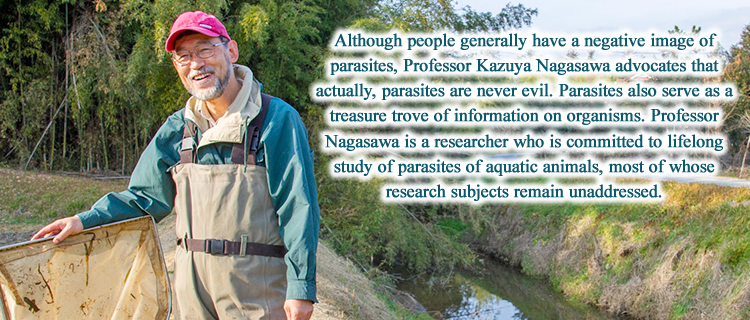
|
| |
|
Studying parasites helps understanding of the ecology of their
hosts—Important research for appropriate resource management
|
| |
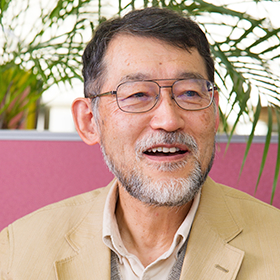 |
|
Professor Nagasawa pursues research into parasites of fish and
other aquatic animals. He catches and dissects aquatic animals such as fish
and shellfish, and removes parasites from the skin and internal organs of
the animals, in order to examine parasites in details.
Professor Nagasawa says, “For instance, if you open the stomach of a fish,
you can only understand what the fish ate one or two hours before. On the
other hand, if you find the parasites in the stomach, you can understand
what the fish ate in the past year. Besides, you can see where the fish was
born and grew up as well as where and how the fish migrated.”
In other words, parasites can be used as a biological indicator, and this is
where their usefulness lies, according to the professor. |
|
| |
The Laboratory of Aquaculture led by Professor Nagasawa has
carried out various research activities for appropriate resource management,
with the aim of increasing fisheries resources.
Among these activities is research on parasites. Major research targets are
parasites of various salmonids, whose juveniles are released into rivers to
grow, and parasites of Japanese eels (Anguilla japonica), which are in
danger of extinction.
He says, “In particular, the ecology of Japanese eels is as yet not well
known. Studying their parasites will help us understand the kinds of
habitats necessary for the eels to prosper, and the type of environment we
should create to increase the survival rate of Japanese eels, whose
population is currently on the decline. We would like to move forward with
our research to reach a level capable of increasing biological
resources.”
|
|
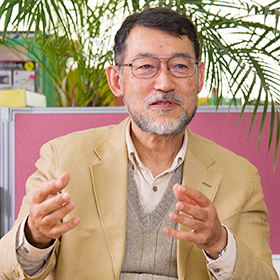 |
| As he points out, it is essential for fisheries to clarify the
relationship between fish and parasites. However, there are very few
scientists working on parasites of aquatic animals, says Professor Nagasawa.
“Of national universities in Japan, such parasitologists can be found only
at the University of Tokyo and Hiroshima University.” |
|
| |
|
Aquaparasitology, a discipline involving both microscopic and macroscopic
perspectives—while studying microscopic parasites, actually overlooking the natural
world as a whole
|
| |
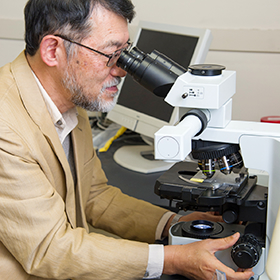 |
|
Due to a very limited number of researchers, very little has
been clarified in the academic discipline called “aquaparasitology.”
However, Japan is a leading country in this field, with world-leading
research capabilities.
“I truly enjoy our research in this discipline,” Professor Nagasawa mentions
with a smile. He added that “Generally, biologists study a single organism.
But we study not only parasites, but also the host animals on which adult
parasites depend, as well as temporary hosts utilized by larval
parasites.”
In other words, we research three types of organisms. In addition, we have
to understand the environment in which the respective life forms are living.
This means that those who pursue aquaparasitology should overlook the entire
natural world. |
|
| |
Moreover, since a fish containing parasites can be eaten by a
bird or whale, we should understand about the bird and whale as well. To put
it another way, in this field we learn about various groups of organisms in
the natural world. For researchers who like learning about living creatures,
there is no more interesting theme than this.”
He also pointed out one more aspect of the research on parasites.
“In Japan, there are about 4,200 species of fish. However, parasites of only
about 400 – 500 fish species have been identified. In other words, so far,
researchers have studied parasites of only one-tenth of all fish species
found in our country. The number of species of shellfish, squid and octopus
living in Japan totals approximately 6,000, and the number of sea urchin and
starfish species stands at 2,000. Accordingly, to clarify aquatic parasites,
we have to continue endless work of catching and dissecting tens of
thousands of aquatic animals, sampling and examining their parasites, and
then assigning names to the unknown parasites we find.” Actually, such
research activities are beneficial not only for enhancing fishery stocks,
but also leads to creating a more accurate taxonomy, which is another
important task, he says. |
|
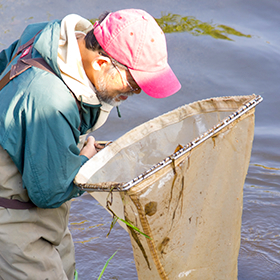 |
|
| |
|
Fostering all-around players who can do anything, from catching fish to
dissecting and sketching
|
| |
|
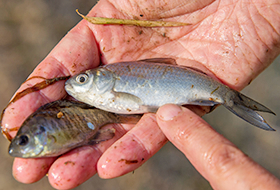
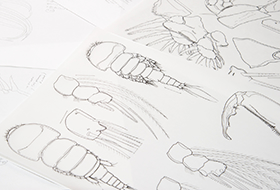
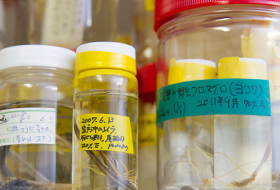
|
|
Developing an accurate taxonomy requires detailed studies of
parasites’ shapes and structures. Then the studied parasites are sketched
and given scientific names for registration. Such a series of processes
seems quite demanding. However, Professor Nagasawa says with a laugh, “I
will continue pursuing this work until I die. The number of research
subjects is so enormous that I can’t die.” Looking back at his life as a
researcher, he expressed it as “extremely happy.”
Most parasites of aquatic animals have been unknown to the academic
community, so discovering them is “an important challenge to advance
research on biological diversity,” he mentioned.
In his laboratory, students begin their research activities by catching fish
by themselves, as did Professor Nagasawa. “Therefore, students should be
good at fishing, and talk with fishermen. Aquaparasitology is not a
discipline that can be pursued through book learning alone.”
Students who are very curious and love learning about living creatures will
be able to find great pleasure in aquaparasitology. However, if they want to
work as researchers in this discipline, they should become all-around
players who can do anything. Students are also required to acquire expertise
and skills on their own, through step by step hands-on experience, since
Professor Nagasawa has adopted a “no spoon-feeding” approach in guiding his
students.
“I am pleased that students of Hiroshima University have grown so robustly,
and there are a number of students to whom I can trust the future of our
research. They will eventually play active roles in the international arena.
I feel very honored and privileged to be able to see the students’ growth,”
he says with a smile. He expects that even more capable successors will
follow suit. |
|
| |
| Kazuya Nagasawa |
Professor
Laboratory of Aquaculture
School of Applied Biological Science
Hiroshima University
September 1, 2005 – Present: Professor, Hiroshima University
Posted on Aug 12, 2014
|
| |









